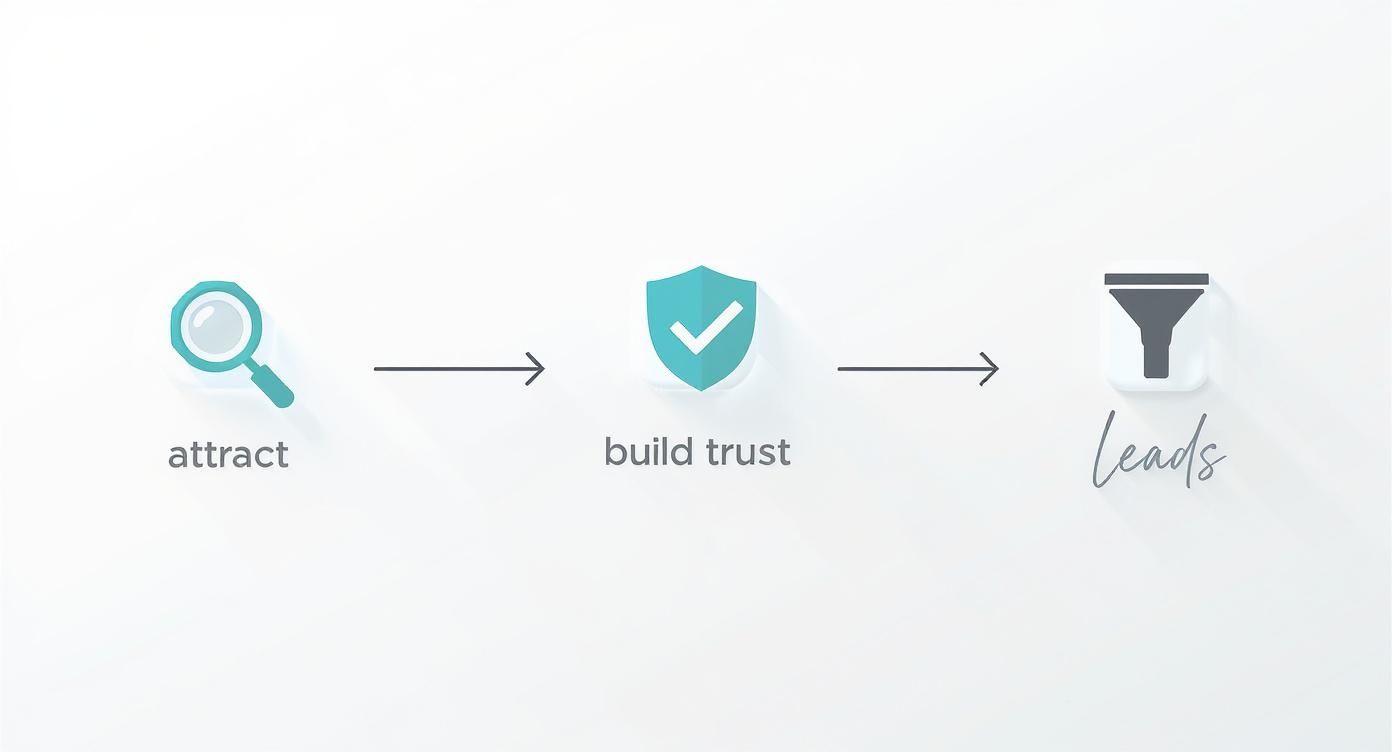Let's be clear: in today's market, blogging for your business isn't some 'nice-to-have' extra—it's a core part of any serious growth plan. Think of your blog as your company's digital storefront, but one that sits on the busiest high street imaginable. It’s open 24/7, ready to greet visitors, answer their questions, and start building relationships long after you’ve switched off for the day.
Why Modern UK Businesses Must Blog to Compete
A business blog is easily one of the most powerful tools in your marketing kit. It takes your website from being a static, online brochure and transforms it into a dynamic engine for generating leads. Whilst a post on social media might grab attention for a day, a well-written blog article can serve your business for years, steadily pulling in organic traffic and cementing your authority in your field.
This is a massive shift from how things used to work. Customers are savvier than ever, doing their homework and researching heavily before they even think about making a purchase. Your blog is your chance to meet them right at that critical moment, offering real value and solid answers.
Building Trust Through Expertise
Consistently publishing insightful content does more than just fill up your website; it positions your company as a trusted expert. When you regularly share articles that genuinely solve your audience's problems, you're building credibility. You foster a relationship long before they're ready to buy, and that's the foundation of modern marketing—give value first.
When you're constantly providing useful insights, you establish your company as a real leader. To get a better handle on this, you can learn more about what is thought leadership marketing and see how it shapes brand perception.
A Direct Line to Your Customers
Blogging gives you a direct channel to communicate with the people you want to reach. It's your space to let your brand's personality shine, share what your company stands for, and speak directly to the challenges your customers are facing. You just can't replicate that kind of connection with generic advertising.
A business blog isn't just about writing articles. It’s built on four core pillars: fuelling your search engine optimisation, building audience trust, generating qualified leads, and communicating your unique brand voice. If you ignore it, you’re leaving a huge competitive advantage on the table.
This approach is central to any effective digital marketing effort. Blogging is one of the most efficient investments you can make because it directly supports so many other activities. The articles you publish aren't just one-off pieces; they become permanent assets that work for you around the clock. In fact, it's a key component in many proven small business growth strategies used by successful UK companies to get ahead of the competition.
Core Pillars of Business Blogging
To put it simply, a business blog serves several vital functions that drive tangible results. The table below breaks down exactly how each strategic pillar translates into a key business outcome.
| Strategic Pillar | Primary Business Outcome |
|---|---|
| Search Engine Optimisation | Attracts organic traffic by answering customer questions and ranking for relevant keywords. |
| Audience Trust and Authority | Builds credibility and positions your company as an industry expert, fostering trust with potential clients. |
| Lead Generation Engine | Converts website visitors into qualified leads through targeted content and clear calls-to-action. |
| Brand Voice and Connection | Communicates your company's values and personality, creating a stronger connection with your audience. |
Each pillar works together, turning your blog from a simple content hub into a powerful, multi-faceted business tool.
The Measurable Returns of Strategic Blogging
Right, let's move beyond the theory and talk about what really matters: the tangible, bottom-line impact of a well-run business blog. Whilst building authority is great, the real magic of blogging for businesses is its power to generate measurable returns. It’s not about just pumping out content; it’s about creating assets that keep delivering value long after you hit ‘publish’.
Think of a single blog post as a long-term investment. Unlike a paid advert that vanishes the moment your budget runs out, a high-quality article can pull in organic traffic, generate leads, and grow your audience for months, or even years. It's this snowball effect that makes a consistent blogging strategy so financially smart.
This digital asset works for you 24/7, answering customer questions and nudging them towards a purchase, all without any ongoing costs. The initial investment in time and resources pays for itself over and over again.
From Traffic to Tangible Profits
The direct financial returns from a blog become crystal clear once you know what to look for. The journey from a casual website visitor to a paying customer often begins with one article. By hitting on a specific pain point or answering a burning question, your blog post attracts the right kind of people—those actively searching for the solutions you offer.
The content marketing industry, which is heavily fuelled by business blogging, is set to reach an incredible global value, and UK companies are catching on fast. Research shows that businesses that blog see a staggering 13-fold higher return on investment (ROI) compared to those that don't. On top of that, companies with active blogs generate an average of 55% more website visitors, which has a direct knock-on effect on their visibility and lead generation. You can dig into more data on the significant ROI of business blogging.
Key Performance Indicators to Prove Value
To really get a grip on your blog's impact, you need to track the right key performance indicators (KPIs). These metrics go beyond simple page views and show how your content is actually contributing to business growth.
- Organic Traffic Growth: Keep an eye on the number of visitors finding your blog through search engines. A steady climb is a clear sign your SEO efforts are paying off and more potential customers are discovering you.
- Lead Conversion Rates: Track how many readers take the next step, whether that’s downloading a guide, signing up for your newsletter, or requesting a quote. This metric ties your content directly to lead generation.
- Customer Acquisition Cost (CAC): A lower CAC is one of the biggest wins from blogging. By attracting organic leads, you cut down your reliance on pricey paid ads, making every new customer more profitable.
The infographic below neatly sums up the core jobs your blog performs to get these results.

As you can see, your blog isn't just a one-trick pony. It first attracts an audience, then builds the trust needed for them to finally convert into genuine leads.
A smart investment in strategic content creation isn't an expense; it's a direct contribution to your sales pipeline. Every article should be viewed as a salesperson working tirelessly to attract, educate, and convert your ideal customers.
Take a local electrician in Cambridge, for instance. They could write a detailed guide on "How to Choose the Right EV Charger for Your Home." This article would naturally attract local homeowners searching for that exact information. By including a clear call-to-action like "Get a Free Installation Quote," the post turns an informational search into a solid business lead, showing a clear and direct return from a single piece of content.
Creating Content Your Audience Actually Wants

Here's a hard truth about business blogging: the biggest hurdle isn't the writing. It's figuring out what to write about in the first place—creating content that people genuinely want to read. Churning out articles that don't land with your audience is like shouting into an empty room. It’s a complete waste of time and energy.
The secret to effective blogging for businesses is to stop guessing what your audience wants and start listening to what they actually need.
Your content strategy needs to be built on a deep understanding of your audience. It's about stepping into their shoes, identifying their biggest frustrations, and answering their most burning questions. When you create content that solves a real problem, you stop being just another business and become an indispensable resource they trust.
Uncovering Your Audience's Pain Points
Before you even think about writing a single word, you need to do some digging. Don't worry, this isn't about complex market analysis; it's about practical investigation. The goal is to map out the topics your ideal customers are actively searching for, giving you a clear blueprint for your content.
Here are a few straightforward ways to find out what's really on your audience's mind:
- Talk to Your Sales Team: What are the most common questions and objections they hear every day? Every single one of them is a potential blog post.
- Analyse Your Competitors: Take a look at the most popular articles on your competitors' blogs. What topics are getting traction? Use this for inspiration, but always aim to create something far better and more thorough.
- Use Free SEO Tools: Tools like AnswerThePublic literally show you the exact questions people are typing into search engines. This is a goldmine for proven content ideas.
- Check Online Forums: Platforms like Reddit or Quora are full of people asking for advice. Find the subreddits or topics relevant to your industry and take note of the problems that keep popping up.
This research ensures every article you publish is targeted, relevant, and has a built-in audience just waiting for it.
Structuring Your Content for Authority
Once you know what your audience wants, you need to structure it in a way that establishes your authority and helps you show up in search results. The most effective way to do this is with the "pillar and cluster" model. Think of it like a book.
The pillar page is your core chapter—a comprehensive guide on a broad topic. The cluster content consists of smaller, more specific articles that link back to the main pillar, acting like detailed sub-sections.
For example, a marketing agency's pillar post might be "The Ultimate Guide to Digital Marketing for Small Businesses." The cluster posts could then dive into specific topics like "A Beginner's Guide to Google Ads," "How to Create a Social Media Calendar," and "Email Marketing Essentials." Each of these would link back to the main guide. This structure signals to search engines that you have deep expertise on the subject. To get a better handle on this strategic approach, exploring some proven content marketing best practices can provide a valuable framework.
Choosing Formats That Drive Engagement
Just writing walls of text won't cut it anymore. People are selective. In the UK, whilst the average business blog post is around 1,333 words, readers only spend about 52 seconds on each one. That’s not a lot of time to make an impact.
This highlights just how important it is to create content that is concise, visually engaging, and compelling. The data backs this up: blogs that use relevant images get 94% more views, and 24% of bloggers now embed videos to keep people on the page longer.
To hold your reader's attention, you've got to mix things up. Vary your content formats to keep things interesting.
- How-To Guides: These are incredibly popular because they offer step-by-step solutions to common problems. They're practical, easy to share, and brilliant for showing off your expertise.
- Case Studies: Nothing builds trust like showing real-world results. A detailed case study walks a potential customer through exactly how you solved a problem for a client, making your value tangible.
- Expert Interviews: Featuring an interview with an industry expert adds instant credibility to your blog. It also helps you tap into their audience, expanding your reach.
- Data-Driven Reports: If you can gather original data through surveys or research, presenting it in a report is a powerful way to generate backlinks and position yourself as a go-to authority.
By mixing these formats, you keep your blog fresh and appeal to different types of readers, ensuring all your hard work gets the attention it deserves.
Integrating SEO for Maximum Search Visibility
Incredible content is worthless if your ideal customers can't find it. This is where search engine optimisation (SEO) comes in, acting as the bridge between your valuable insights and the people actively looking for them. Don’t let the term intimidate you; SEO isn't just for technical experts.
At its core, SEO is about making your content easy for search engines like Google to understand and categorise. Think of it like organising a library. You’re the author, and your blog posts are the books. SEO is how you label each book correctly so the librarian (Google) knows exactly where to put it and can recommend it to the right readers.
Effective blogging for businesses relies on this organisation. Without it, even the most brilliant articles will get lost on a dusty digital shelf, never to be discovered.
On-Page SEO: The Foundations of Visibility
On-page SEO refers to all the optimisations you make directly on your blog posts. These are the fundamental signals you send to search engines to tell them what your content is about. Getting these basics right is non-negotiable.
The whole thing kicks off with keyword research. This isn't about stuffing your articles with repetitive phrases; it's about understanding the exact words and questions your potential customers are typing into Google. By identifying these, you can align your content directly with their needs. Our guide offers a detailed walkthrough on how to choose keywords for your website to get you started.
Once you have your target keywords, you need to weave them in strategically.
- SEO-Friendly Headlines: Your headline is the first thing both readers and search engines see. It must be compelling enough to earn a click whilst clearly including your primary keyword.
- Compelling Meta Descriptions: This is the short snippet of text that appears under your headline in search results. Whilst not a direct ranking factor, a well-written meta description acts as an advert for your post, dramatically boosting click-through rates.
- Using Internal Links: Linking between your own blog posts creates a logical path for both users and search engine crawlers. This helps build topical authority, signalling to Google that you have a deep well of knowledge on a particular subject.
Building Authority Beyond Your Website
Whilst on-page elements are crucial, search engines also look at off-page signals to determine your website's authority and trustworthiness. The most important of these are backlinks—links from other reputable websites pointing to yours.
Think of a backlink as a vote of confidence. When another respected website links to your article, they are essentially telling Google, "This content is valuable and trustworthy." The more high-quality votes you get, the higher your authority and rankings will climb.
Creating content that naturally attracts these links is the ultimate goal. This means producing original research, insightful guides, and unique resources that others in your industry will want to reference and share. It’s a long-term strategy, but it’s the most sustainable way to build a strong online presence.
Monitoring your progress is just as important as implementing these tactics. To keep a close eye on your content's search performance, an innovative tool like this free AI-powered ChatGPT Rank Tracker free tool can be a game-changer. It allows you to see which keywords you're ranking for and spot opportunities for improvement.
By combining solid on-page optimisation with a smart strategy to earn off-page authority, you ensure all the hard work you put into your content gets the audience it deserves.
Building a Sustainable Blogging Workflow

Consistency is the absolute bedrock of a successful business blog. If you’re just publishing posts whenever you find a spare moment, you’ll never build the kind of momentum needed to draw in and keep an audience. The secret is to craft a sustainable workflow that lets you churn out a steady stream of top-notch content without burning out your team.
This isn’t about working harder; it’s about working smarter. A well-oiled workflow transforms blogging for businesses from a dreaded chore into a manageable, predictable part of your marketing machine. It adds structure, keeps quality high, and means you’re never scrambling for ideas at the eleventh hour.
The whole process starts with a realistic content calendar. This is more than just a list of topics—it’s a strategic roadmap that plots out your posts weeks, or even months, in advance. Your calendar should be a direct reflection of your bigger business goals, supporting product launches, seasonal pushes, and key marketing campaigns with relevant, timely articles.
Planning Your Content Pipeline
A content calendar brings clarity and focus to your whole team. It’s your blueprint for planning articles around specific keywords, customer pain points, and different stages of the buyer’s journey. By mapping everything out, you can guarantee a healthy mix of topics that speaks to all your different audience segments.
Start by brainstorming a massive list of potential topics rooted in your audience research. Once you have that, you can start slotting them into a weekly or monthly schedule. It’s this forward-thinking that separates a strategic blog from a random collection of posts, turning your content into a powerful, cohesive asset.
Choosing Your Content Creation Model
With a plan in place, you need a reliable way to actually get the content made. The best model for you will come down to your budget, in-house skills, and how much time your team can realistically commit. Each option has its own clear perks.
- In-House Team: This route gives you maximum control over your brand voice and technical accuracy. Your own experts have a deep understanding of your products and can produce truly authentic, authoritative content.
- Freelance Writers: Bringing in specialist freelance writers can be a seriously cost-effective way to get high-quality content produced at scale. They offer fresh perspectives and expertise, which frees up your team to focus on their core roles.
- AI-Assisted Creation: Think of artificial intelligence as a co-pilot, not the author. It's fantastic for sparking ideas, structuring outlines, and smashing through writer's block, but you absolutely need a human in the driver's seat to check for quality and originality.
The smartest blogging workflows often blend these models. You might have an in-house expert create the brief, a freelancer draft the article, and an editor use AI tools to polish and optimise it for SEO.
The reality of modern blogging is that you need a high volume of quality content to cut through the noise. Fresh data shows UK bloggers now need over 300 posts to earn a meaningful income of over £820 a month—a massive leap from the 50-99 posts needed in 2023. And whilst up to 80% of UK bloggers use AI tools to help, only 6% are letting it write full articles. This just goes to show how vital human expertise still is, especially when 36.4% of businesses report traffic drops from algorithm updates. You can find more insights on the rising demands of content creation on nealschaffer.com.
Maximising Value Through Repurposing
Getting a great blog post published is just the start. If you want to squeeze every last drop of value from your investment, you’ve got to repurpose that single piece of content into a whole range of other assets. This simple strategy massively extends the life and reach of your hard work.
For instance, one in-depth article can easily become:
- A whole series of social media posts pulling out key quotes and stats.
- The script for a short, punchy YouTube video.
- An interesting snippet for your next email newsletter.
- A slick, shareable infographic that summarises the main takeaways.
This approach ensures your core message connects with a much bigger audience across different platforms, cementing your authority and funnelling more traffic back to the original article. It’s the final piece of the puzzle in building a truly efficient and sustainable blogging machine.
Measuring Success to Optimise Your Strategy
Hitting ‘publish’ on a blog post is just the start. The real magic happens when you start digging into the data, understanding what’s working, and making smart adjustments along the way. Blogging for businesses isn't about throwing content at a wall and hoping something sticks; it's a calculated process of using data to refine your approach and get the best possible return.
It’s easy to get caught up in vanity metrics like page views or social media likes. Whilst they can give you a nice ego boost, they don’t tell you if your blog is actually helping your business. You need to look deeper and focus on the data that shows how people are behaving and whether they’re taking action.
Key Metrics That Truly Matter
To get a real sense of your blog's performance, you need to track a few essential Key Performance Indicators (KPIs). The good news is, you don't need expensive software to get started. Free tools like Google Analytics and Google Search Console are more than powerful enough to give you all the insights you need.
Here are the core metrics you should be keeping a close eye on:
- Organic Traffic: This is a simple one—how many people are finding your blog through search engines? A steady climb here is a great sign that your SEO efforts are paying off.
- Keyword Rankings: By checking Google Search Console, you can see which keywords your articles are ranking for. This tells you what's clicking with search algorithms and where you might have opportunities to improve.
- Time on Page: How long are people actually sticking around to read your content? The longer they stay, the more engaged they are, which suggests your content is genuinely valuable.
- Conversion Rate: This is the big one. It tracks how many readers take the action you want them to, whether that's signing up for a newsletter, downloading an ebook, or getting in touch.
Success in business blogging isn't just about attracting visitors; it's about attracting the right visitors and guiding them towards a meaningful action. Data is the compass that tells you if you're on the right path.
When you focus on these KPIs, you can draw a straight line from your content to real business results. You'll know exactly which articles are bringing in leads and which ones might need a bit of a rethink.
Conducting Regular Content Audits
Data is only useful if you do something with it. A monthly content audit is a simple but incredibly powerful habit to get into. It doesn't have to be a massive undertaking—just a straightforward review to figure out what's working, what isn't, and why.
Set aside some time each month to pull up your top-performing and underperforming posts based on the KPIs above. Start asking the important questions: Why are certain posts driving so much traffic? What do our most successful articles have in common? Why are other posts falling flat?
This regular check-in helps you make smart, data-driven decisions. You might notice, for instance, that all your highest-converting posts are detailed case studies. That’s your cue to create more of them. Or you might find an article stuck on page two of Google that just needs a quick content refresh and a few more internal links to give it the push it needs.
Organising this information is crucial for spotting trends over time. Using a structured framework can help you make sense of the numbers and present them clearly to your team. For a great starting point, check out our comprehensive monthly SEO report template to see how you can structure your findings effectively.
By systematically measuring your performance and optimising your strategy, you’ll turn your blog from a simple content hub into a growth engine that gets better and better over time.
Frequently Asked Questions About Business Blogging
Even with a solid plan, plenty of UK businesses get stuck on the practical side of blogging for businesses. Let's clear up some of the most common questions with direct, actionable answers.
Think of this as your guide to navigating the day-to-day challenges of running a blog that actually works, from getting your posting rhythm right to using new tools without losing your voice. The goal is always the same: deliver real value to your audience.
How Often Should My Business Publish a Blog Post?
Don't fixate on frequency. Consistency is what really matters. For most businesses in the UK, aiming for one high-quality, well-researched post per week is a brilliant and, more importantly, sustainable place to start. That’s enough to build momentum with search engines and keep your audience coming back.
It’s always better to publish one fantastic article a week than four mediocre ones. The real power of blogging builds up over time, so the main goal is to lock in a schedule you can actually stick to without cutting corners on quality. This consistency sends a strong signal of reliability to both your readers and Google.
What Should I Do If I Run Out of Blog Post Ideas?
Hitting a wall with ideas is a common fear, but the fix is simpler than you think: listen to your customers. Think about the questions your sales and support teams field every single day. Every single one is a blog post just waiting to be written.
To keep the ideas flowing, try this:
- Talk to your customers: What are their biggest headaches? What questions do they ask before buying? Your content should solve those problems.
- Use free online tools: Platforms like AnswerThePublic or the 'People also ask' box in Google show you exactly what your audience is searching for.
- Check out the competition: See what topics are working for them, but your mission is to create something far more detailed and helpful. Never just rehash what they’ve already said.
When you build your content calendar around solving genuine customer problems, you’ll never be short of relevant topics.
The most powerful blog content doesn't come from a brainstorm in a boardroom; it comes from the real-world questions your audience is asking. Answer those questions thoroughly, and you'll never run out of valuable topics.
Can I Use AI to Write My Business Blog Posts?
You should treat artificial intelligence as your assistant, not your author. It’s an incredible tool for brainstorming topics, structuring outlines, smashing through writer’s block, or even summarising dense research. Used this way, AI can make your team dramatically more efficient.
However, letting AI write entire articles is a recipe for generic, soulless content that lacks your brand's unique personality and expert insight. Both search engines and human readers are looking for original, authoritative content from real experts. Always have a human specialist review, edit, and inject their own unique value into every single post before it goes live.
Ready to turn your website into a lead-generation engine with strategic SEO? Bare Digital offers a free SEO Health Check to pinpoint your biggest opportunities. In just 24 hours, you'll get a custom proposal with a clear activity plan to boost your rankings and grow your business. Get your no-obligation plan today at https://www.bare-digital.com.








